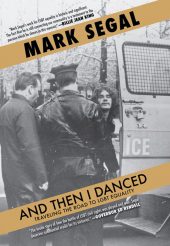 And Then I Danced:
And Then I Danced:
Traveling the Road to LGBT Equality
by Mark Segal
Published by Open Lens (Akashic Books)
Published October 6, 2015
History (memoir) • 400 pgs.
Reviewed by C. Todd White
January 5, 2016.
And Then I Danced: Traveling the Road to LGBT Equality is more than a memoir. It is a handbook for grass-roots activism written by one of the grand masters in the field, Mark Segal, who just celebrated 40 years as publisher of Philadelphia Gay News.
Segal’s life history exemplifies the power of the supportive family in the nurturance of social activism. His parents, Marty and Shirley, remained confident in their son’s north-pointing moral compass, providing a solid home base, support for his activistic antics, and wide latitude for character building. He learned the political ropes from his grandmother, Fannie Weinstein, an active suffragette and ardent defender of civil rights. Through her guidance and his parents unwavering support, one can say that Segal has been a civil rights activist for his entire life.
The book reads like a series of delightful vignettes, every one of which is engaging in its own right. For instance, the “scene” where Segal hangs a giant sheet reading “Gay Power” from the towers of Philadelphia City Hall is hilarious:
For some reason it took the powers-that-be about an hour to hoist the banner back inside. In the meantime I was across the street watching and kicking myself for not taking into consideration the wind…. (103)
Segal was first known for his staging of pickets and “zaps,” acts of consciousness raising on a public scale, in the early 1970s. He first “zapped” the Liberty Bell, where he handcuffed himself to a railing and shouted “Independence for Gay People!” (67). Of course he had been sure to have media friends on hand to ensure the event was covered. The zaps were only effective to the extent of their audience, thus his famous raid of the CBS Evening News with Walter Cronkite, on December 11, 1973, where he interrupted the news to flash a sign stating “Gays Protest CBS Prejudice.” The prank was seen by millions, making Segal the first openly gay man on primetime television.
The strength of this book stems from its many entertaining backstories that demonstrate the forethought and planning that went into the zaps and other increasingly grand events. “Success depended on planning, execution, and security.” Pushing ever onward, Segal often pauses to reflect on the way, amazed at his own success. It felt as if he and his cohort in the Gay Liberation Front, and then the Gay Activist Alliance and The Gay Raiders, had pushed the world—and it moved.
Segal triumphed through many of his early legal and political ordeals because he stayed on point, was clear about his message, and remained a nice, articulate man despite his youth and shaggy looks. It is interesting to read of the transition from hippie protester to consummate (and well suited) political insider—there are generational insights here as Segal exemplifies the upward mobility of many baby boomers.
While the personal is indeed political, as the feminists say, Segal’s story suggests that with perseverance and planning, politics can become personal as well. Outsiders who become insiders can effect powerful change provided they remain personable, focused, informed, and articulate. Few remain untarnished in the political fray, yet Segal makes the impossible seem easy. His moral compass remains spot on.
And Then I Danced is an invaluable first-hand account of the history of LGBT activism that belongs on the shelves of every public or academic library and in every LGBT community center across the nation. Segal should be congratulated for writing this honest, engaging, and action-inspiring memoir. His story is highly readable and loaded with common-sense advice for how to raise social consciousness while continuing the fight for the rights of LGBT individuals and our growing community.
©2015, 2016 by C. Todd White.
This review has been reprinted by Out In Jersey magazine and The Empty Closet.

